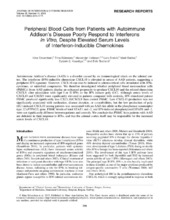| dc.contributor.author | Edvardsen, Kine Susann Waade | en_US |
| dc.contributor.author | Bjånesøy, Trine Elholm | en_US |
| dc.contributor.author | Hellesen, Alexander | en_US |
| dc.contributor.author | Breivik, Lars Ertesvåg | en_US |
| dc.contributor.author | Bakke, Marit | en_US |
| dc.contributor.author | Husebye, Eystein Sverre | en_US |
| dc.contributor.author | Bratland, Eirik | en_US |
| dc.date.accessioned | 2016-01-04T12:42:14Z | |
| dc.date.available | 2016-01-04T12:42:14Z | |
| dc.date.issued | 2015-05-15 | |
| dc.Published | Journal of Interferon and Cytokine Research 2015, 35(10):759-770 | eng |
| dc.identifier.issn | 1079-9907 | |
| dc.identifier.uri | https://hdl.handle.net/1956/10855 | |
| dc.description.abstract | Autoimmune Addison's disease (AAD) is a disorder caused by an immunological attack on the adrenal cortex. The interferon (IFN)-inducible chemokine CXCL10 is elevated in serum of AAD patients, suggesting a peripheral IFN signature. However, CXCL10 can also be induced in adrenocortical cells stimulated with IFNs, cytokines, or microbial components. We therefore investigated whether peripheral blood mononuclear cells (PBMCs) from AAD patients display an enhanced propensity to produce CXCL10 and the related chemokine CXCL9, after stimulation with type I or II IFNs or the IFN inducer poly (I:C). Although serum levels of CXCL10 and CXCL9 were significantly elevated in patients compared with controls, IFN stimulated patient PBMC produced significantly less CXCL10/CXCL9 than control PBMC. Low CXCL10 production was not significantly associated with medication, disease duration, or comorbidities, but the low production of poly (I:C)-induced CXCL10 among patients was associated with an AAD risk allele in the phosphatase nonreceptor type 22 (PTPN22) gene. PBMC levels of total STAT1 and -2, and IFN-induced phosphorylated STAT1 and -2, were not significantly different between patients and controls. We conclude that PBMC from patients with AAD are deficient in their response to IFNs, and that the adrenal cortex itself may be responsible for the increased serum levels of CXCL10. | en_US |
| dc.language.iso | eng | eng |
| dc.publisher | Mary Ann Liebert, Inc. | eng |
| dc.relation.ispartof | <a href="http://hdl.handle.net/1956/10940" target="blank">Autoimmunity and viral immunity in Addison’s disease</a> | |
| dc.rights | Attribution CC BY | eng |
| dc.rights.uri | http://creativecommons.org/licenses/by/4.0 | eng |
| dc.subject | Blood Cells | eng |
| dc.subject | Autoimmune Addison's Disease | eng |
| dc.title | Peripheral blood cells from patients with autoimmune Addison's disease poorly respond to interferons in vitro, despite elevated serum levels of interferon-inducible chemokines | en_US |
| dc.type | Peer reviewed | |
| dc.type | Journal article | |
| dc.date.updated | 2015-12-21T20:17:23Z | |
| dc.description.version | publishedVersion | en_US |
| dc.rights.holder | Copyright Kine Edvardsen et al. 2015 | |
| dc.identifier.doi | https://doi.org/10.1089/jir.2014.0171 | |
| dc.identifier.cristin | 1291766 | |
| dc.subject.nsi | VDP::Medisinske Fag: 700 | en_US |

